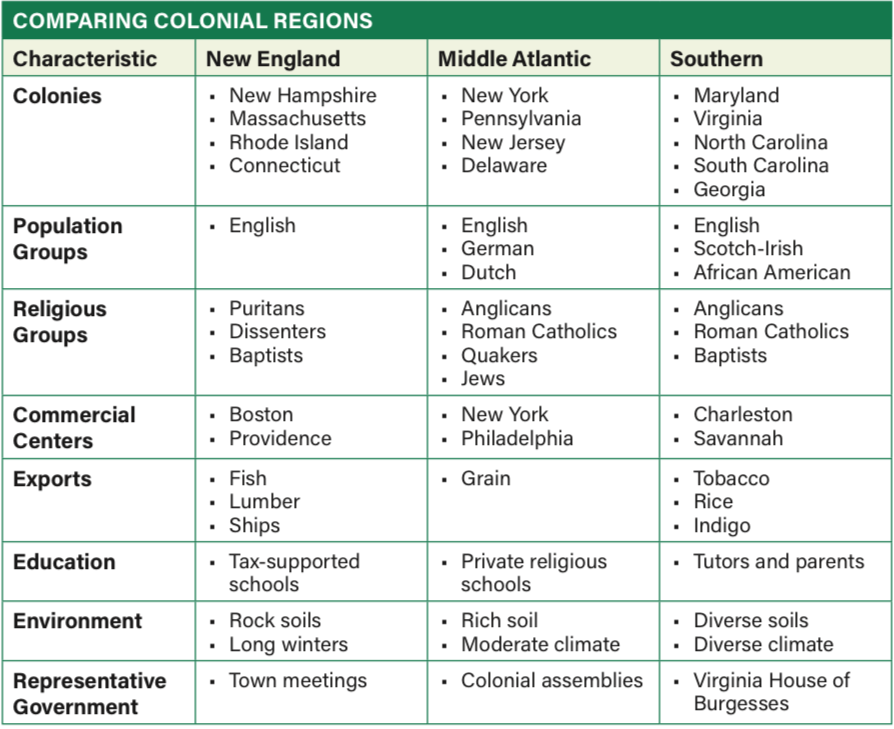Topic 2.8 Comparisons in Period 2
I. Political Exchanges & Governance: Comparison Between Britain & Colonies
A. British Political Influence
Charter colonies were technically under British control but operated with locally elected assemblies.
Royal governors were appointed by the King, yet colonial legislatures (e.g., Virginia House of Burgesses, 1619)held significant local power.
Colonists often modeled their political systems after Britain's constitutional monarchy and English common law.
B. Colonial Self-Governance
Colonists sought more autonomy, especially in frontier or religiously-motivated colonies (e.g., Pennsylvania, Rhode Island).
Town hall meetings and assemblies (especially in New England) promoted early democratic principles.
Conflicts like Bacon’s Rebellion (1676) revealed tensions between colonial interests and royal governance.
Comparison
Similarity: Colonists believed in property rights, voting rights (for land-owning males), and representation.
Difference: Colonists developed more participatory local governments, sometimes resisting royal interference.
II. Economic Exchanges: Mercantilism & Colonial Response
A. Mercantilism & Trade
Britain imposed the Navigation Acts (1651, 1660, 1663) to control colonial trade.
Only allowed trade with England or through English ships.
Created a list of “enumerated goods” (e.g., tobacco, sugar, indigo) that could only be exported to Britain.
Colonies provided raw materials, and Britain sold back manufactured goods (example of economic dependency).
B. Colonial Reaction
Smuggling became common (e.g., in New England) as merchants sought greater trade freedom.
Despite restrictions, many colonies prospered, especially in agriculture (South) and shipping (North).
Salutary neglect during the early 1700s allowed colonies some economic freedom.
Comparison
Similarity: Colonial economy tied to Britain’s wealth under mercantilism.
Difference: Colonists developed distinct regional economies and began to resist restrictions over time.
III. Cultural Exchanges: Religion & Identity
A. British Religious Influence
Church of England (Anglican Church) was the state religion in Britain and established in colonies like Virginia and the Carolinas.
Many colonists still identified as British subjects with shared cultural norms (language, law, dress, literature).
B. Religious Diversity in Colonies
Puritans in Massachusetts Bay sought religious reform, not tolerance.
Quakers in Pennsylvania (William Penn) promoted religious toleration and pacifism.
Catholics in Maryland (Lord Baltimore) passed the Act of Toleration (1649) to protect religious freedom (for Christians).
Great Awakening (1730s–40s): A religious revival movement that challenged religious authority, promoted equality before God, and strengthened American identity.
Comparison
Similarity: Colonists brought over religious ideas from Britain, including religious conflicts.
Difference: Greater religious diversity and experiments in tolerance occurred in the colonies, especially due to necessity and settlement patterns.
IV. Interaction with Native Americans: Support vs. Control
Colonial Perspective
Colonists often sought British military protection against Native resistance (e.g., King Philip’s War, 1675).
Colonies wanted freedom to expand westward, but British policy was often cautious or restrictive.
British Perspective
Britain wanted to maintain trade relationships with Native Americans and limit costly wars.
Tension between colonial expansionism and British diplomatic goals.
Comparison
Similarity: Both sought to benefit economically from Native lands.
Difference: Colonists were more aggressive in pushing into native territory; Britain tried (unsuccessfully) to balance control and diplomacy.
V. Summary: Key Arguments & Comparative Conclusions
Key Argument Possibilities:
The British colonies had an evolving relationship with the mother country—one that was complex and often contradictory.
Politically and economically, colonies mimicked Britain but also pushed for more autonomy.
Culturally, especially in religion, the colonies developed greater diversity and toleration out of necessity.
Economic dependency under mercantilism clashed with colonial desire for economic opportunity and expansion.
